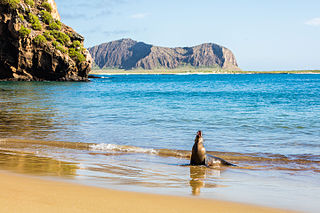
The Galápagos Islands are an archipelago of volcanic islands in the Eastern Pacific, located around the Equator 900 km (560 mi) west of the mainland of South America. They form the Galápagos Province of the Republic of Ecuador, with a population of slightly over 33,000 (2020). The province is divided into the cantons of San Cristóbal, Santa Cruz, and Isabela, the three most populated islands in the chain. The Galápagos are famous for their large number of endemic species, which were studied by Charles Darwin in the 1830s and inspired his theory of evolution by means of natural selection. All of these islands are protected as part of Ecuador's Galápagos National Park and Marine Reserve.

Emmelina monodactyla is a moth of the family Pterophoridae found in Africa, Asia, Europe and North America. It was first described by Carl Linnaeus in 1758.
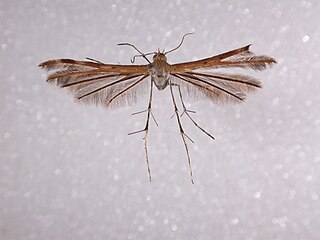
Megalorhipida leucodactyla is a species of moth of the family Pterophoridae that has a pantropical distribution.

Pterophorus albidus is a moth of the family Pterophoridae. It is distributed in Africa, south and south-east Asia, including New Guinea and Australia, as well as Japan (Kyushu) and the Ryukyu Islands.
The brown leaffolder is a moth of the family Pterophoridae. It is known from Sri Lanka.
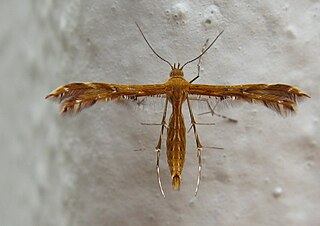
Stenodacma wahlbergi is a moth of the family Pterophoridae described by Philipp Christoph Zeller in 1851. It is known from Japan, China, Saudi Arabia, Iran, Sri Lanka, India, Central, East and South Africa, St. Helena, Mauritius, the Seychelles and Rodrigues. It has recently been recorded from Vietnam. Records for Australia were based on synonymisation with Stenodacma pyrrhodes.
Pterophorus niveodactyla is a moth of the family Pterophoridae. It is found in Taiwan, China, India, Sri Lanka, Malaya, Java, Sumatra, the Philippines, Borneo, New Guinea, Micronesia, the Bismarck Islands, the Solomon Islands and São Tomé & Principe.
Bipunctiphorus nigroapicalis is a moth of the family Pterophoridae. It is known from the Galápagos Islands and Venezuela.
Postplatyptilia huigraica is a moth of the family Pterophoridae. It is known from Brazil, Colombia, Costa Rica, Ecuador, Peru and Venezuela.
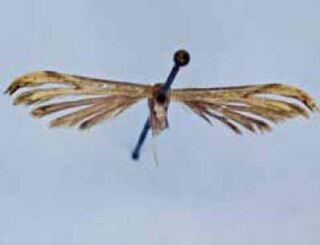
Emmelina buscki is a moth of the family Pterophoridae first described by William Barnes and Arthur Ward Lindsey in 1921. It is found in North America.

Hellinsia nephogenes is a moth of the family Pterophoridae. It is found on the Galapagos Islands.

Hellinsia cristobalis is a moth of the family Pterophoridae. It is found on the Galapagos Islands.

Hellinsia delospilus is a moth of the family Pterophoridae. It is found in Peru and Ecuador.

Hellinsia argutus is a moth of the family Pterophoridae. It is found in Colombia, Ecuador and Peru.

Emmelina suspiciosus is a moth of the family Pterophoridae. It is found in Ecuador.

Hellinsia ochricostatus is a moth of the family Pterophoridae that is found in Colombia and Ecuador.
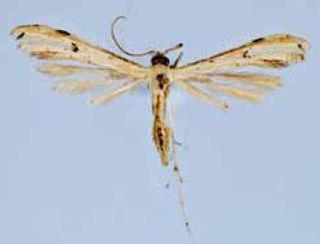
Adaina ipomoeae is a moth of the family Pterophoridae. It is found in Cuba, Jamaica, Puerto Rico, Guadeloupe, the Dominican Republic, Grenada, and Florida.

Adaina scalesiae is a moth of the family Pterophoridae that is endemic to the Galapagos Islands, where it was discovered by Bernard Landry on Bella Vista on April 1, 1992, and on May 25 of the same year on the island of Santa Cruz. The species was also found in Volcan Darwin, a province 15 kilometres (9.3 mi) from Puerto Villamil, on May 25, and 400 metres (1,300 ft) above sea level on Pinta Island where it was found from March 13 to 21. The species is attracted to various lamps including mercury-vapor lamps.

Helcystogramma convolvuli, the sweet potato moth, sweetpotato webworm moth, sweetpotato leaf roller or black leaf folder, is a moth of the family Gelechiidae. It is mainly found in Asia and Africa, but there are also records from Oceania, the Middle East, the Caribbean and Florida in the United States. The species is also found on the Canary Islands and Madeira.
Utetheisa devriesi is a moth in the family Erebidae. It was described by Alan H. Hayes in 1975. It is endemic to the Galápagos Islands.















